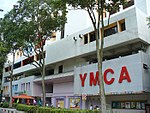Kenpeitai East District Branch

The Kempeitai East District Branch was the headquarters of the Kempeitai, the Japanese military police, during the Japanese occupation of Singapore from 1942 to 1945. It was located at the old YMCA building, at the present site of Singapore's YMCA Building on Stamford Road. Opened in 1911, the distinctive Art Deco YMCA building was the site of interrogation and torture of many innocent civilians, including the war heroine Elizabeth Choy. After the war, the Singapore government erected several memorials with some at the former massacre sites. In 1995, the former site of the old YMCA building was gazetted by the National Heritage Board as one of the eleven World War II sites of Singapore.
Excerpt from the Wikipedia article Kenpeitai East District Branch (License: CC BY-SA 3.0, Authors, Images).Kenpeitai East District Branch
Fort Canning Road, Singapore Museum
Geographical coordinates (GPS) Address Nearby Places Show on map
Geographical coordinates (GPS)
| Latitude | Longitude |
|---|---|
| N 1.2973861111111 ° | E 103.84852777778 ° |
Address
Fort Canning Road
Fort Canning Road
178903 Singapore, Museum
Singapore
Open on Google Maps









